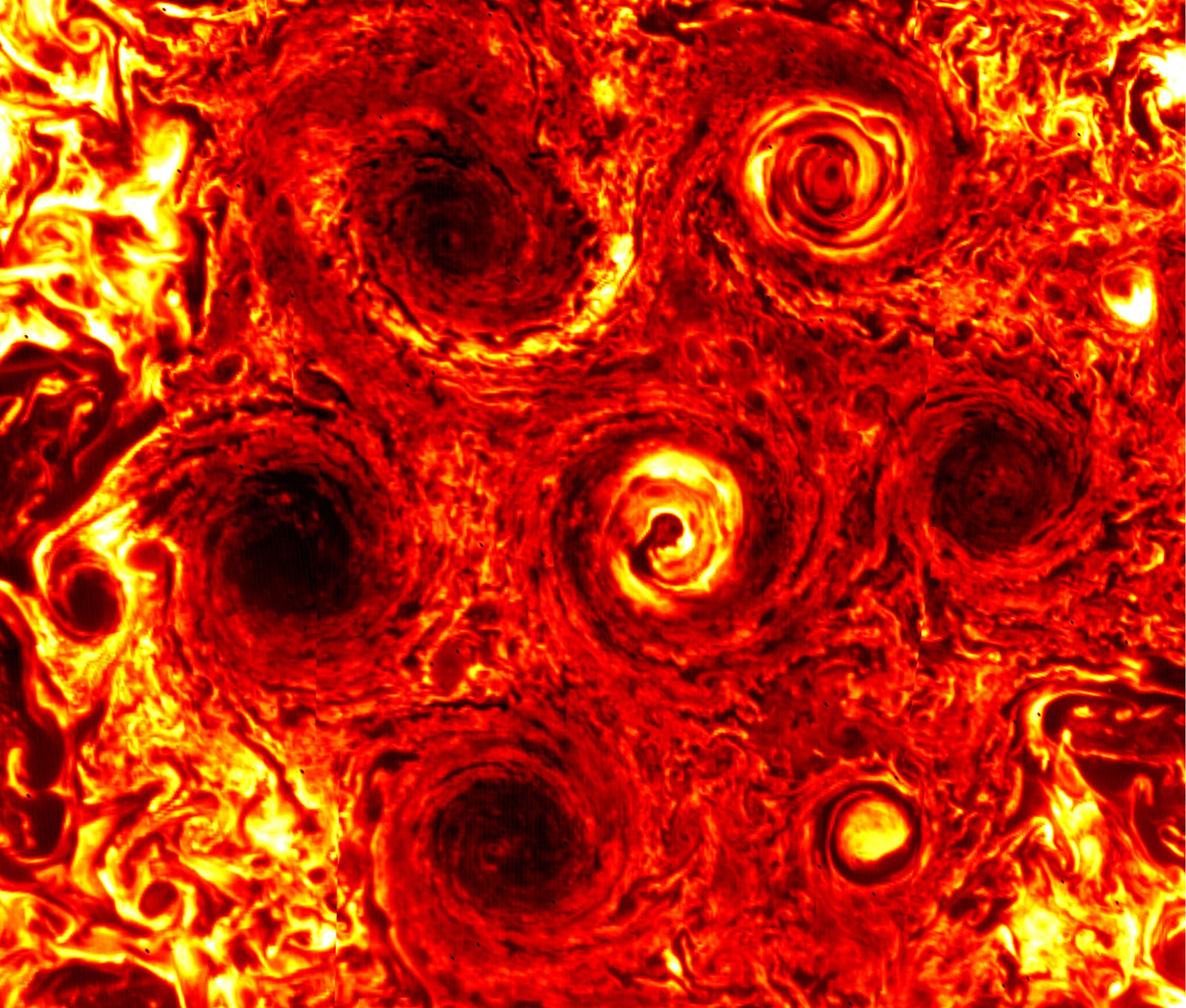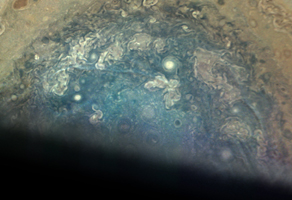
SAN FRANCISCO — NASA's Juno probe discovered a giant new storm swirling near Jupiter's south pole last month, a few weeks after pulling off a dramatic death-dodging maneuver.
Juno spied the newfound maelstrom, which is about as wide as Texas, on Nov. 3, during its most recent close flyby of Jupiter. The storm joins a family of six other cyclones in Jupiter's south polar region, which Juno had spotted on previous passes by the gas giant. (Those encounters also revealed nine cyclones near Jupiter's north pole, by the way.)
The southern tempests are arrayed in a strikingly regular fashion. Previously, five of them had formed a pentagon around a central storm, which is as wide as the continental United States. With the new addition, that girdling structure is now a hexagon.
Related: In Photos: Juno's Amazing Views of Jupiter
More Photos: The Most Powerful Storms of the Solar System

"These cyclones are new weather phenomena that have not been seen or predicted before," Cheng Li, a Juno scientist from the University of California, Berkeley, said in a statement yesterday (Dec. 12).
"Nature is revealing new physics regarding fluid motions and how giant planet atmospheres work," he added. "We are beginning to grasp it through observations and computer simulations. Future Juno flybys will help us further refine our understanding by revealing how the cyclones evolve over time."
Juno orbits Jupiter on a highly elliptical path every 53 Earth days, gathering most of its data when it comes closest to the giant planet. And those encounters are quite close indeed: During the Nov. 3 pass, the 22nd science flyby of Juno's $1.1 billion mission, the probe skimmed a mere 2,175 miles (3,500 kilometers) above Jupiter's cloud tops, NASA officials said.
Get the Space.com Newsletter
Breaking space news, the latest updates on rocket launches, skywatching events and more!
But it took some fancy flying to make sure Juno survived the experience. The mission team determined that the probe's trajectory would take Juno into Jupiter's shadow for 12 hours on Nov. 3. And that likely would've been a death sentence for the solar-powered probe.
"We would've gotten cold. Really, really cold," Juno project scientist Steve Levin, of NASA's Jet Propulsion Laboratory (JPL) in Pasadena, California, said during a press conference here yesterday at the annual fall meeting of the American Geophysical Union (AGU), where the team announced the new results.
Related: Target: Jupiter — 9 Amazing Missions to Our Largest Planet
But the navigation team at JPL came up with a solution: "jumping Jupiter's shadow." On Sept. 30, Juno's handlers directed the solar-powered probe to fire its small reaction-control engines in pulses for 10.5 hours. This pushed the probe's path steadily outward — and, ultimately, out of the shadow path altogether, Levin explained.
"Without that maneuver, without the creative genius of the folks at JPL on the navigation team, we wouldn't have the beautiful data that we have to show you today," he said.
Juno launched in 2011 and arrived in orbit around Jupiter on July 4, 2016. The spacecraft is studying Jupiter's composition and gravitational and magnetic fields, among other things. The data Juno is gathering should help researchers better understand how Jupiter — and, by extension, the solar system — formed and evolved, mission team members have said.
The initial mission plan called for Juno to tighten its science orbit considerably, down to 14 Earth days. But the team called off the engine burns that would have achieved this reduction after discovering issues with the probe's fuel-delivery system. So, Juno will stay in the 53-day orbit for the duration of its mission, which currently goes through July 2021.
- Photos: Most Powerful Storms of the Solar System
- Jupiter's Atmosphere
- Behold! Jupiter Is a Breathtaking 'Marble' in This NASA Juno Photo
Mike Wall's book about the search for alien life, "Out There" (Grand Central Publishing, 2018; illustrated by Karl Tate), is out now. Follow him on Twitter @michaeldwall. Follow us on Twitter @Spacedotcom or Facebook.

Join our Space Forums to keep talking space on the latest missions, night sky and more! And if you have a news tip, correction or comment, let us know at: community@space.com.

Michael Wall is a Senior Space Writer with Space.com and joined the team in 2010. He primarily covers exoplanets, spaceflight and military space, but has been known to dabble in the space art beat. His book about the search for alien life, "Out There," was published on Nov. 13, 2018. Before becoming a science writer, Michael worked as a herpetologist and wildlife biologist. He has a Ph.D. in evolutionary biology from the University of Sydney, Australia, a bachelor's degree from the University of Arizona, and a graduate certificate in science writing from the University of California, Santa Cruz. To find out what his latest project is, you can follow Michael on Twitter.
-
rod Interesting report and I note this in the report "But it took some fancy flying to make sure Juno survived the experience. The mission team determined that the probe's trajectory would take Juno into Jupiter's shadow for 12 hours on Nov. 3. And that likely would've been a death sentence for the solar-powered probe."Reply
On Mars, last year during the Mars opposition in July 2018, a global dust storm raged. One rover had solar power, the other rover had nuclear power. The nuclear powered rover continued to work :) -
mintaslanxor Reply
We are hip to your not-so-subtle anti-solar political dig, except that solar-powered energy applications are different on earth from those in space.rod said:Interesting report and I note this in the report "But it took some fancy flying to make sure Juno survived the experience. The mission team determined that the probe's trajectory would take Juno into Jupiter's shadow for 12 hours on Nov. 3. And that likely would've been a death sentence for the solar-powered probe."
On Mars, last year during the Mars opposition in July 2018, a global dust storm raged. One rover had solar power, the other rover had nuclear power. The nuclear powered rover continued to work :) -
Muir Am I the only one to see a person reading in this picture? Well, doing my MSc in Space Physiology currently and maybe just studying too hard! Still, I'm calling him/her The Student of Jupiter and it's going on my wall! :)Reply -
Hantayo Nice bit of "flying gang" not too much different than trying to put a multi million dollar aircraft down on a pitching and rolling flight deck of a carrier.Reply









